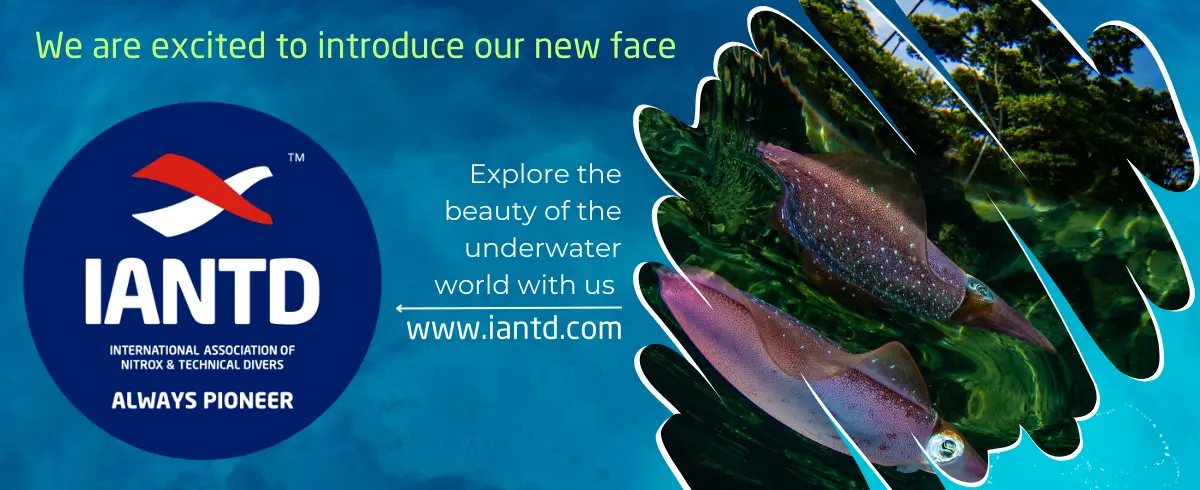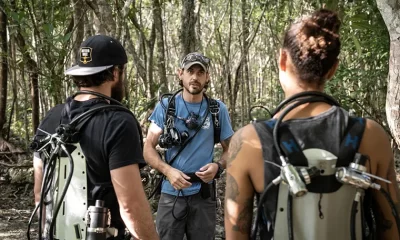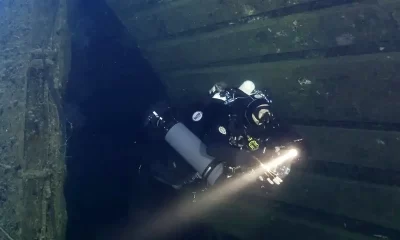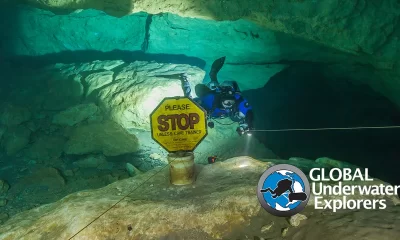Education
ISO Training Standards for Rebreather Divers
The Rebreather Training Council (RTC) spent nearly four years developing a set of international ISO standards for rebreather training, similar to what was done for recreational open circuit training. They are now being implemented by many of the training agencies. Here PADI’s Industry Relations & Training Executive and former RTC chair Mark Caney explains where the standards came from, what they involve, and what they will mean for rebreather training. Has your agency gone ISO CCR?
By Mark Caney
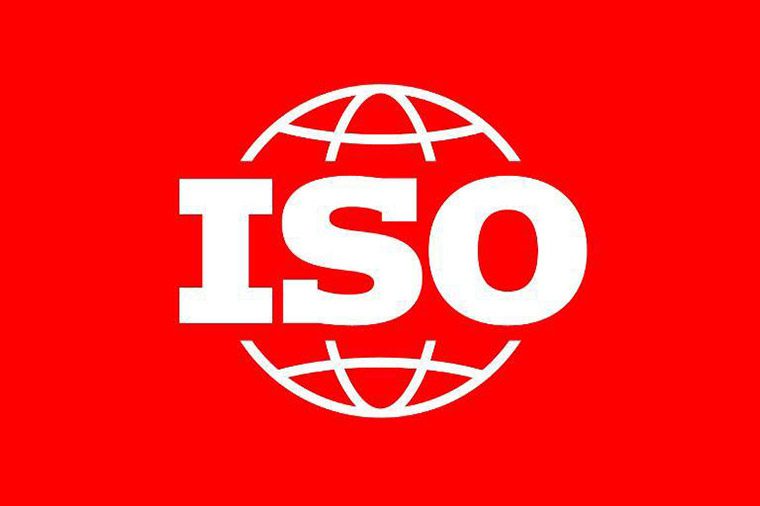
You may have heard that International Organization for Standardization (ISO) standards have been developed to cover the training of rebreather divers and instructors, and most of these have already been published. This article explains where these standards come from, and what the effect will be on how rebreather divers are trained.
The recreational diving industry has a long and proven track record of effective self-regulation. The industry has historically published some standards for the training of rebreather divers through such bodies as the Rebreather Training Council (RTC) and Rebreather Education Safety Association (RESA) but these were never properly integrated into a single set of diving industry standards until now. In 2019, the RTC decided to start work on a series of standards within the framework of the International Organization for Standardization (ISO). Previously, more than a dozen standards had been negotiated for recreational open circuit diver training under the ISO system, so it was a logical choice to use the same protocol for rebreather training.
The ISO development process is very transparent and open to any ISO member country that wishes to take part. Nearly all countries are members, so this essentially means that any of them can send representatives to the international meetings where the standards are negotiated. Although, in the past, such meetings were held as physical meetings, in recent years they are nearly always conducted as virtual meetings. Any given country can send one or more experts to take part in the discussions and negotiations, and these are usually senior figures from the diving community of that country. Additionally, some specific international industry groups are allowed to take part in the negotiations and send delegates, such as RTSC, RTC and RESA.
The development of the standards takes place over several distinct steps, and versions of the developing draft are distributed internationally for comment until the final version is presented, which is then voted on by all the countries interested. If passed, the ISO standard is then published. This whole process typically takes two or three years for each standard, so it is not a quick procedure, but it is very thorough. Standards are then reviewed every five years, to see if they need any form of updating.
The standards related to rebreather diving are:
ISO 24804 “Recreational diving services – Requirements for rebreather diver training – No- decompression diving”
A diver able to make dives with a rebreather not requiring mandatory decompression stops using a nitrox or air diluent to a maximum of 30 m/100 ft.
ISO 24805 “Recreational diving services – Requirements for rebreather diver training – Decompression diving to 45 m”
A diver able to make dives with a rebreather requiring mandatory decompression stops using a nitrox or air diluent to 40-45 m/131-148 ft with trimix diluent.
ISO 24806 “Recreational diving services – Requirements for rebreather diver training – Decompression diving to 60 m”
A diver able to make dives with a rebreather requiring mandatory decompression stops to a maximum depth of 60 m/197 ft using bailout gas mixtures that are not hypoxic at surface pressures.
ISO 24807 “Recreational diving services – Requirements for rebreather diver training – Decompression diving to 100 m”
A diver able to make dives with a rebreather requiring mandatory decompression stops to depths of 100 m/328 ft or beyond using any gas mixtures.
ISO 24808 “Recreational diving services – Requirements for rebreather instructor training”
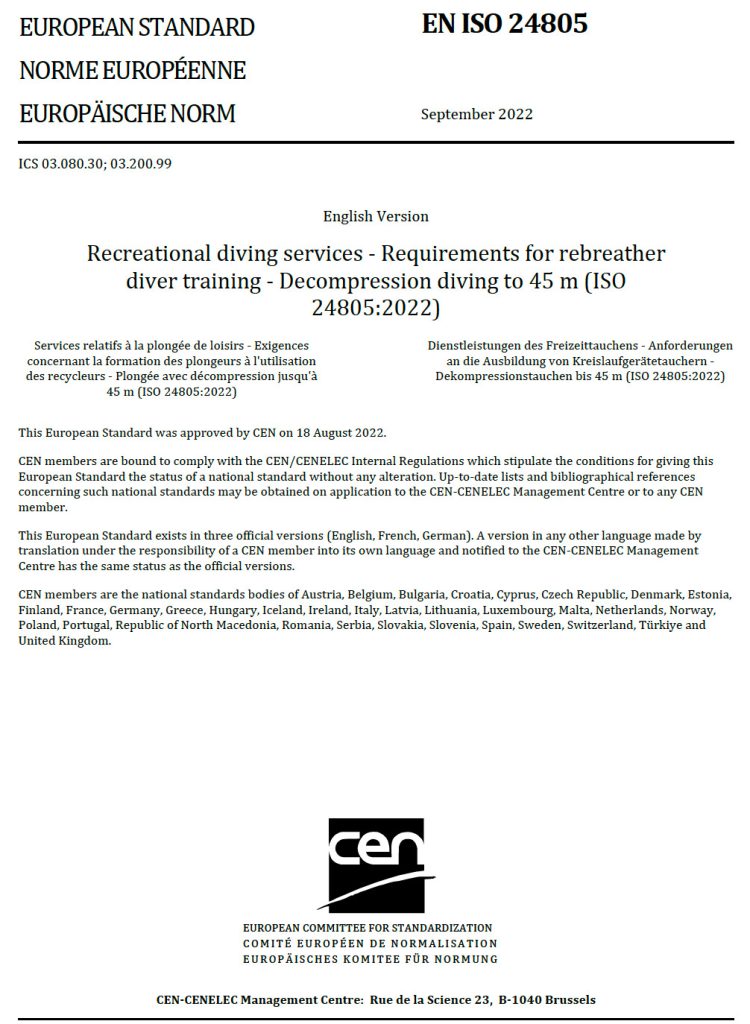
The first four of these ISOs have recently been completed so are in effect now. The remaining standard covering instructor courses is still being worked on but is likely to be finalized later in 2023 or in early 2024.
It is not necessary for every diver or instructor to have a copy of these standards, although if you would like to get a copy, you can do so by applying to your National Standards Body, and you can find a list of these here: https://www.iso.org/members.html . The standards are primarily aimed at the people who run training organizations, and they will certainly have copies of the standards so that they can ensure their courses are compliant with them.
What effect will this have on divers? All the main providers of rebreather diver training are members of the Rebreather Training Council (RTC), and they have all agreed to adopt any ISO standards as they are published. So you can expect that any RTC member will soon align their standards with these standards if they have not already done so. They have to ensure that their standards at least meet the requirements of the ISO Standards, but they can exceed them if they wish.
Will this have a dramatic effect on how divers are trained? The short answer is no, because it became clear when the standards were negotiated that most training organizations were teaching similar content in their courses. What has now been codified is the specific number of dives and depths required for each course, and this will mean some level of adjustment is needed for a number of training organizations.
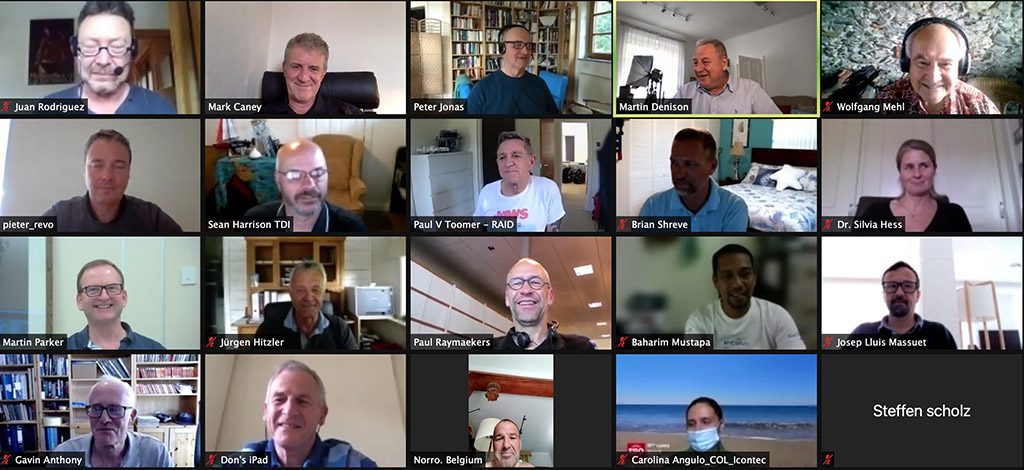
Here are some examples of requirements contained in the standards that may be new for some existing training courses:
- It has been found that gas density is a significant concern when it comes to planning deeper dives, and so it is now a requirement that this is included in the theory segment of the relevant courses.
- Any on-board diluent gas should have a PO2 higher than 1.1 bar at the maximum depth.
- The breathing rate for bailout needs to be calculated with a minimum respiratory minute volume (RMV) of 50 l/min for the bottom and ascent phase, but on deeper dives, this can be dropped to 25 l/minute ten minutes after reaching the first decompression stop or after ending the first stop, whichever is sooner.
- The use of Mouthpiece Retaining Straps (MRS) is referenced in all the standards, although it is not a required skill.
- Crossover protocols for divers moving from one unit to another are included in the 60 m and 100 m standards.
Having a set of ISO standards in place that have been agreed upon by diving industry members offers a long-term form of security for us. Rather than having any arbitrary regulations imposed on us by local governments, these standards are ones which we have developed ourselves because we believe they best standardize the way rebreather divers are trained. Several governments around the world have elected to take the previously published framework of ISO standards and make them a requirement for diver training in their country. By doing so, they knew that they thereby automatically adopted protocols that would reflect internationally agreed best practices. They simultaneously also ensured that their countries would be competitive in the substantial global diving tourism market by not imposing unrealistic regulations that had been made up locally. The ISO standards have also been welcomed by governments around the world because, by recognizing and adopting them, those governments are relieved of the onerous burden of creating and keeping up-to-date their own regulations. They simply choose to state that diving activities must take place according to the best practices detailed in the standards and know they have applied reasonable and appropriate protection for both the consumers and workers in the diving industry.
Any training organization could claim to have courses which comply with the ISO standards, so how can a consumer know if their claims are true? There exists an independent auditing body specifically for this reason – EUF Certification International, and any training agency can volunteer to have their training system independently audited to see if they meet the requirements of the ISO standards. The agencies that do so are certified as complying with the standards, and their status is periodically reviewed. All the major training organizations have been approved by this process in respect of the range of recreational open-water training courses, so it is likely we will see a similar thing happen with these new rebreather courses.
DIVE DEEPER
ISO: International Organization for Standardization
RTC: The Rebreather Training Council
RESA: THE REBREATHER EDUCATION & SAFETY ASSOCIATION

Mark Caney has worked for PADI since 1996, and was instrumental in setting up PADI’s TecRec rebreather training range. Recently, he has been actively involved in creating a series of ISO standards for rebreather diver training and scientific diving. Mark is the President of the European Underwater Federation, has twice been President of the Rebreather Training Council, and continues to serve in the senior positions in leading diving industry bodies such as the World Recreational Scuba Training Council.



